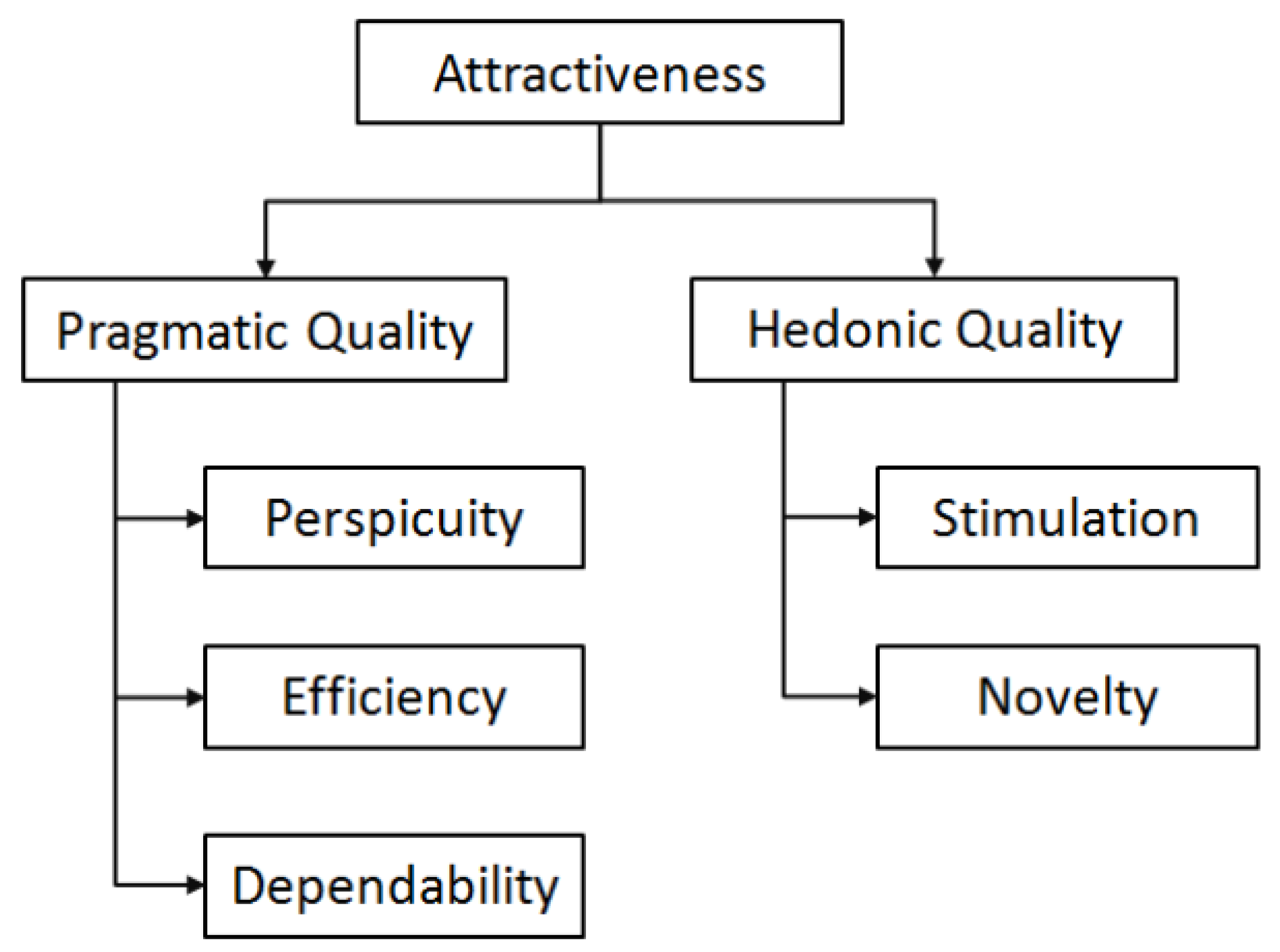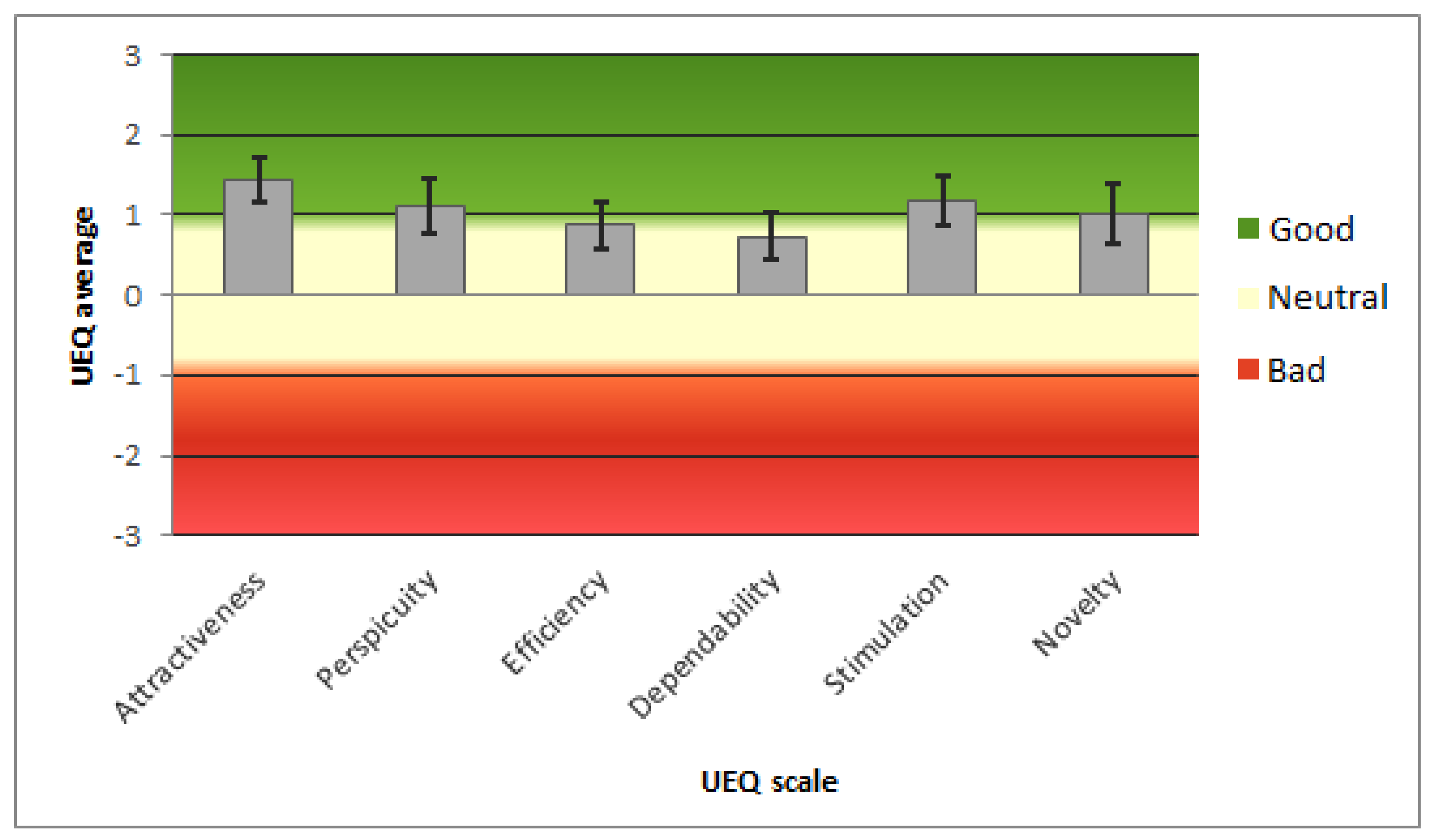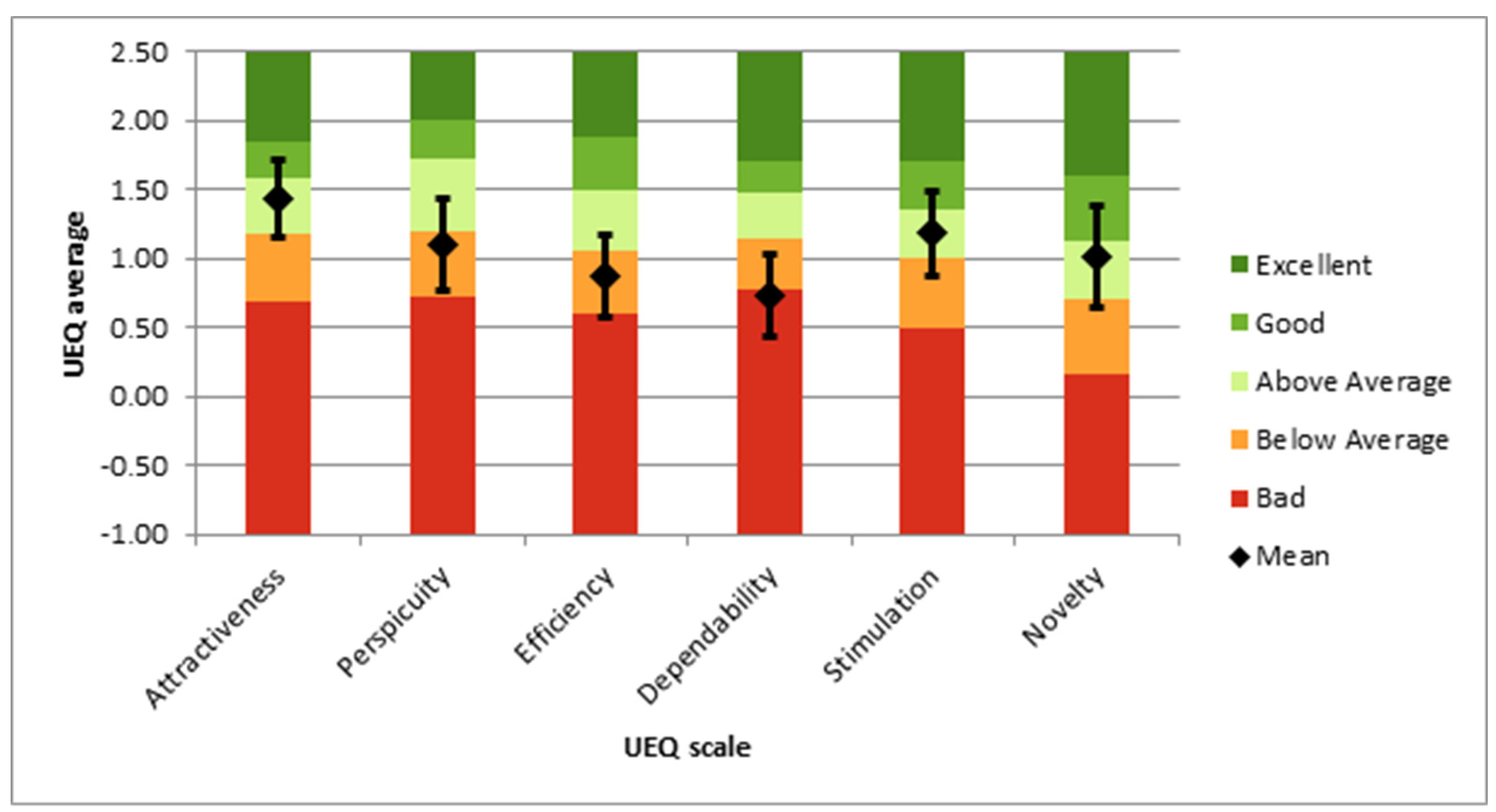User Experience of a Mobile App in a City Tour Game for International Doctoral Students
Abstract
:1. Introduction
2. Materials and Methods
City Tour Questionnaire for Game Users
3. Results and Discussion
3.1. Study Participants and Contextual Results
3.2. User Experience with a Mobile Augmented Reality App
- (a)
- Attractiveness (6 suggestions), where the main proposal was to improve the multimedia resources quality (5);
- (b)
- Efficiency (7), which was divided into improving energy use efficiency (4) and revising some interaction features (3);
- (c)
- Perspicuity (6), regarding the improvement in some texts’ clarity;
- (d)
- Dependability (14), the majority of these are regarding pedagogical issues (12);
- (e)
- Others (8), regarding access issues (IoS version and availability on app stores).
| UEQ Scale | Sub-Category | Frequency | Citation Example |
|---|---|---|---|
| Attractiveness | Improve multimedia resources quality | 5 | “videos are too long” (Q4) |
| Revise the app scheme of colors | 1 | “The pink is not the best color.” (Q34) | |
| Efficiency | Improve energy use efficiency | 4 | “it needs a lot of battery” (Q53) |
| Revise interaction features | 3 | “language switching option could be clearer” (Q42) | |
| Perspicuity | Reformulate texts/information for improved clarity | 6 | “map instructions could be clearer” (Q4) |
| Dependability | Improve pedagogical quality | 12 | “Don’t show the pictures on the app (or only parts of it), so that there is more incentive to find the place in real!” (Q17) |
| Address app bugs | 1 | “AR isn´t well supported, and the app crashed at some point.” (Q16) | |
| Include security endorsement warnings | 1 | “should have alerts about traffic. People get too involved and don´t pay attention.” (Q31) | |
| Stimulation | - | 0 | - |
| Novelty | - | 0 | - |
| Others | Make iOS version | 6 | “Please make this application/games available in iOS, not only android user could enjoy the intuitiveness” (Q27) |
| Make it available in official app stores | 2 | “place it on play store” (Q32) | |
| No suggestions | - | 22 | “thank you for developing this for us!” (Q6) |
4. Conclusions
Author Contributions
Funding
Institutional Review Board Statement
Informed Consent Statement
Data Availability Statement
Acknowledgments
Conflicts of Interest
References
- Pombo, L.; Marques, M.M. An App That Changes Mentalities about Mobile Learning—The EduPARK Augmented Reality Activity. Computers 2019, 8, 37. [Google Scholar] [CrossRef]
- Laine, T. Mobile Educational Augmented Reality Games: A Systematic Literature Review and Two Case Studies. Computers 2018, 7, 19. [Google Scholar] [CrossRef]
- Pombo, L.; Marques, M.M. The Potential Educational Value of Mobile Augmented Reality Games: The Case of EduPARK App. Educ. Sci. 2020, 10, 287. [Google Scholar] [CrossRef]
- Weerasinghe, M.; Quigley, A.; Ducasse, J.; Pucihar, K.Č.; Kljun, M. Educational Augmented Reality Games. In Augmented Reality Games II; Springer International Publishing: Cham, Switzerland, 2019; pp. 3–32. [Google Scholar]
- Floricel, S. Understanding the Nature and Effects of Digital Games in Promoting Sustainability. Glob. Econ. Obs. 2020, 8, 125–134. [Google Scholar]
- Pombo, L.; Marques, M.M. Learning with the Augmented Reality EduPARK Game-Like App: Its Usability and Educational Value for Primary Education. In Proceedings of the Computing Conference, London, UK, 16–17 July 2019; Arai, K., Bhatia, R., Kapoor, S., Eds.; Springer: Cham, Switzerland, 2019; Volume 997, pp. 113–125, ISBN 9783030228705. [Google Scholar]
- Pombo, L.; Marques, M.M.; Oliveira, S. Lessons Learned—EduPARK; UA Editora: Aveiro, Portugal, 2019; ISBN 978-972-789-613-4. [Google Scholar]
- Mascheroni, G.; Cuman, A. Net Children Go Mobile: Final Report. Deliverables D6.4 & D5.2; SAGE Publications: Milano, Italy, 2014. [Google Scholar]
- Marques, M.M.; Pombo, L. Game-Based Mobile Learning with Augmented Reality: Are Teachers Ready to Adopt It? In Smart Innovation, Systems and Technologies; Rehm, M., Saldien, J., Manca, S., Eds.; Springer: Singapore, 2020; Volume 158, pp. 207–218. ISBN 9789811396519. [Google Scholar]
- Amanatidis, N. Augmented Reality in Education and Educational Games-Implementation and Evaluation: A Focused Literature Review. Comput. Child. 2022, 1, em002. [Google Scholar] [CrossRef]
- Liu, S.; Gao, S.; Ji, X. Beyond Borders: Exploring the Impact of Augmented Reality on Intercultural Competence and L2 Learning Motivation in EFL Learners. Front. Psychol. 2023, 14, 1234905. [Google Scholar] [CrossRef] [PubMed]
- Lampropoulos, G.; Keramopoulos, E.; Diamantaras, K.; Evangelidis, G. Integrating Augmented Reality, Gamification, and Serious Games in Computer Science Education. Educ. Sci. 2023, 13, 618. [Google Scholar] [CrossRef]
- Marques, M.M.; Pombo, L. The Impact of Teacher Training Using Mobile Augmented Reality Games on Their Professional Development. Educ. Sci. 2021, 11, 404. [Google Scholar] [CrossRef]
- Laugwitz, B.; Held, T.; Schrepp, M. Construction and Evaluation of a User Experience Questionnaire. In HCI and Usability for Education and Work, Proceedings of the 4th Symposium of the Workgroup Human-Computer Interaction and Usability Engineering of the Austrian Computer Society, Graz, Austria, 20–21 November 2008; Holzinger, A., Ed.; Springer: Berlin/Heidelberg, Germany, 2008; pp. 63–76. [Google Scholar]
- Rauschenberger, M.; Schrepp, M.; Perez-Cota, M.; Olschner, S.; Thomaschewski, J. Efficient Measurement of the User Experience of Interactive Products. How to Use the User Experience Questionnaire (UEQ). Example: Spanish Language Version. Int. J. Interact. Multimed. Artif. Intell. 2013, 2, 39. [Google Scholar] [CrossRef]
- Schankin, A.; Budde, M.; Riedel, T.; Beigl, M. Psychometric Properties of the User Experience Questionnaire (UEQ). In Proceedings of the Conference on Human Factors in Computing Systems, New Orleans, LA, USA, 30 April–5 May 2022; Barbosa, S., Lampe, C., Appert, C., Shamma, D.A., Drucker, S., Williamson, J., Yatani, K., Eds.; Association for Computing Machinery: New York, NY, USA, 2022; pp. 1–11. [Google Scholar] [CrossRef]
- Hassenzahl, M.; Schöbel, M.; Trautmann, T. How Motivational Orientation Influences the Evaluation and Choice of Hedonic and Pragmatic Interactive Products: The Role of Regulatory Focus. Interact. Comput. 2008, 20, 473–479. [Google Scholar] [CrossRef]
- Kushendriawan, M.A.; Santoso, H.B.; Putra, P.O.H. Martin Schrepp Evaluating User Experience of a Mobile Health Application ‘Halodoc’ Using User Experience Questionnaire and Usability Testing. J. Sist. Inf. 2021, 17, 58–71. [Google Scholar] [CrossRef]
- Sabukunze, I.D.; Arakaza, A. User Experience Analysis on Mobile Application Design Using User Experience Questionnaire. Indones. J. Inf. Syst. 2021, 4, 15–26. [Google Scholar] [CrossRef]
- Salehudin, M.; Zurqoni, Z.; Robingatin, R.; Syobah, S.N.; Janah, F.; Rorimpandey, W.H.F.; Subakti, H. Mobile Learning With Discord Application as Creative Teaching. TEM J. 2023, 12, 1697–1705. [Google Scholar] [CrossRef]
- Davidavičienė, V.; Raudeliūnienė, J.; Viršilaitė, R. Evaluation of User Experience in Augmented Reality Mobile Applications. J. Bus. Econ. Manag. 2021, 22, 467–481. [Google Scholar] [CrossRef]
- Yin, R.K. Case Study Research and Applications: Design and Methods, 6th ed.; SAGE Publications, Inc.: Los Angeles, CA, USA, 2017. [Google Scholar]
- Harrison, H.; Birks, M.; Franklin, R.; Mills, J. Case Study Research: Foundations and Methodological Orientations. Forum Qual. Sozialforsch. 2017, 18, 19. [Google Scholar] [CrossRef]
- Forman, J.; Damschroder, L. Qualitative Content Analysis. In Empirical Methods for Bioethics: A Primer; Jacoby, L., Siminoff, L.A., Eds.; Elsevier: Oxford, UK, 2008; Volume 11, pp. 39–62. ISBN 0762312661. [Google Scholar]
- Guay, F.; Vallerand, R.J.; Blanchard, C. On the Assessment of Situational Intrinsic and Extrinsic Motivation: The Situational Motivation Scale (SIMS). Motiv. Emot. 2000, 24, 175–213. [Google Scholar] [CrossRef]
- Lee, W.W.S.; Yang, M. Effective Collaborative Learning from Chinese Students’ Perspective: A Qualitative Study in a Teacher-Training Course. Teach. High. Educ. 2020, 28, 221–237. [Google Scholar] [CrossRef]
- Cronbach, L.J. Coefficient Alpha and the Internal Structure of Tests. Psychometrika 1951, 16, 297–334. [Google Scholar] [CrossRef]
- De Sa, M.; Churchill, E.F. Mobile Augmented Reality: Exploring Design and Prototyping Techniques. In Proceedings of the MobileHCI’12: 14th International Conference on Human-Computer Interaction with Mobile Devices and Services, San Francisco, CA, USA, 21–24 September 2012; pp. 221–230. [Google Scholar] [CrossRef]
- Christensen, K.; West, R.E. The Development of Design-Based Research. In Foundations of Learning and Instructional Design Technology: The Past, Present, and Future of Learning and Instructional Design Technology; West, R.E., Ed.; EdTech Books: London, UK, 2018. [Google Scholar]
- Marangunić, N.; Granić, A. Technology Acceptance Model: A Literature Review from 1986 to 2013. Univers. Access Inf. Soc. 2015, 14, 81–95. [Google Scholar] [CrossRef]
- Sebastián-López, M.; de Miguel González, R. Mobile Learning for Sustainable Development and Environmental Teacher Education. Sustainability 2020, 12, 9757. [Google Scholar] [CrossRef]
- Schaal, S.; Lude, A. Using Mobile Devices in Environmental Education and Education for Sustainable Development-Comparing Theory and Practice in a Nation Wide Survey. Sustainability 2015, 7, 10153–10170. [Google Scholar] [CrossRef]



| Average | Minimum | Maximum | |
|---|---|---|---|
| Number of participants | 5.2 | 3.0 | 10.0 |
| Game score | 71.4 | 35.0 | 113.0 |
| Score with AR | 15.7 | 5.0 | 30.0 |
| Correct answers | 16.1 | 10.0 | 23.0 |
| Incorrect answers | 8.9 | 4.0 | 15.0 |
| Game duration 1 | 74.9 | 19.0 | 132.0 |
| Number of Participants | Game Score | Score with AR | Correct Answers | Incorrect Answers | Game Duration | |
|---|---|---|---|---|---|---|
| Number of participants | 1.0 | 0.22 | 0.23 | 0.22 | −0.22 | 0.07 |
| Game score | 0.22 | 1.0 | 0.77 | 1.0 | −1.0 | |
| Score with AR | 0.23 | 0.77 | 1.0 | |||
| Correct answers | 0.22 | 1.0 | ||||
| Incorrect answers | −0.22 | −1.0 | ||||
| Game duration | 0.07 |
| UEQ Scale | Alpha |
|---|---|
| Attractiveness | 0.89 |
| Perspicuity | 0.73 |
| Efficiency | 0.61 * |
| Dependability | 0.55 * |
| Stimulation | 0.86 |
| Novelty | 0.86 |
Disclaimer/Publisher’s Note: The statements, opinions and data contained in all publications are solely those of the individual author(s) and contributor(s) and not of MDPI and/or the editor(s). MDPI and/or the editor(s) disclaim responsibility for any injury to people or property resulting from any ideas, methods, instructions or products referred to in the content. |
© 2023 by the authors. Licensee MDPI, Basel, Switzerland. This article is an open access article distributed under the terms and conditions of the Creative Commons Attribution (CC BY) license (https://creativecommons.org/licenses/by/4.0/).
Share and Cite
Marques, M.M.; Pombo, L. User Experience of a Mobile App in a City Tour Game for International Doctoral Students. Educ. Sci. 2023, 13, 1221. https://doi.org/10.3390/educsci13121221
Marques MM, Pombo L. User Experience of a Mobile App in a City Tour Game for International Doctoral Students. Education Sciences. 2023; 13(12):1221. https://doi.org/10.3390/educsci13121221
Chicago/Turabian StyleMarques, Margarida M., and Lúcia Pombo. 2023. "User Experience of a Mobile App in a City Tour Game for International Doctoral Students" Education Sciences 13, no. 12: 1221. https://doi.org/10.3390/educsci13121221
APA StyleMarques, M. M., & Pombo, L. (2023). User Experience of a Mobile App in a City Tour Game for International Doctoral Students. Education Sciences, 13(12), 1221. https://doi.org/10.3390/educsci13121221








